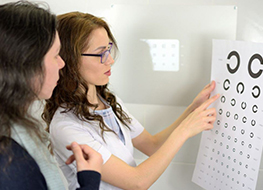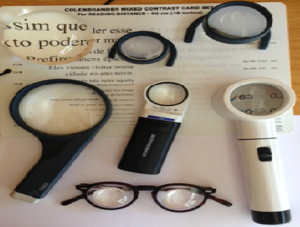Low Vision Aids

Low Vision Aids
Through our low vision clinic we aim to optimize the vision of patients suffering from low vision. In cases where the vision cannot be improved, we aim to train the patients on how to improve their quality of life with the help of low vision aids. This typically includes addressing vision issues causing problems with reading, driving and activities of daily living.
Low vision means having impaired vision that cannot be corrected by glasses, surgery or medication.
What causes low vision? – Some of the most common causes of low vision include age-related macular degeneration, diabetes, and glaucoma. Low vision may also result from cancer of the eye, albinism, brain injury, or inherited disorders of the eye including retinitis pigmentosa. What is the definition of low vision?
OUR PROCESS
A typical low vision evaluation involves a functional assessment including a low vision refraction to find out the problem and its extent. Once the impairment is identified, suitable vision aids such as magnifiers, telescopes and other appropriate assistive technologies are prescribed to maximize the patient’s vision. The patient is then gradually trained on how to use the low vision aids to conduct various daily activities. In addition, visual skills training such as eccentric viewing, blindness skills and referrals to comprehensive blind rehabilitation centers are provided.
- “Partially sighted”: the person has visual acuity between 20/70 and 20/200 with conventional prescription lenses.
- “Legally blind”: the person has visual acuity no better than 20/200 with conventional correction and/or a restricted field of vision less than 20 degrees wide.
- The ratio measurement of vision describes visual acuity, or the sharpness of vision, at 20 feet from an object. For example, having 20/70 vision means that you must be at 20 feet to see what a person with normal vision can see at 70 feet.
Who is most at risk of having low vision?
Anyone can be affected by low vision because it results from a variety of conditions and injuries. Because of age-related disorders like macular degeneration and glaucoma, low vision is more common in adults over age 45 and even more common in adults over age 75. For example, one in six adults over age 45 has low vision; one in four adults over age 75 has low vision.
The most common types of low vision include:
- Loss of central vision: There is a blind spot in the center of one’s vision.
- Loss of peripheral (side) vision: The inability to see anything to either side, above, or below eye level. Central vision, however, remains intact.
- Night blindness: The inability to see in poorly lit areas such as theaters, as well as outside at night.
- Blurred vision: Objects both near and far appear out of focus.
- Hazy vision: The entire field of vision appears to be covered with a film or glare.
What causes low vision?
There may be one or more causes of low vision. These are usually the result of disorders or injuries affecting the eye or a disorder such as diabetes that affects the entire body. Some of the most common causes of low vision include age-related macular degeneration, diabetes, and glaucoma. Low vision may also result from cancer of the eye, albinism, brain injury, or inherited disorders of the eye including retinitis pigmentosa. If you have these disorders or are at risk for them, you are also at greater risk for low vision.